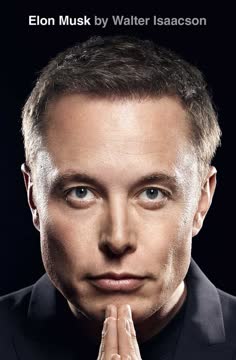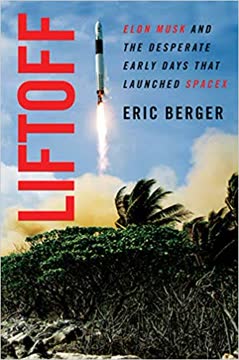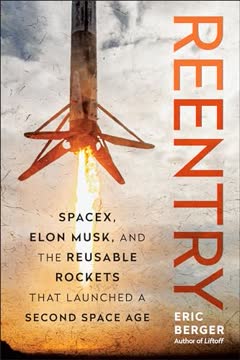Key Takeaways
1. Visionary Leadership and Audacious Goals Drive Innovation
Elon Musk hired them all, molded them into a team, and coaxed them to do the nearly impossible.
Setting the stage. Elon Musk's unwavering vision of making humanity a multiplanetary species served as the driving force behind SpaceX's creation and its relentless pursuit of ambitious goals. This audacious vision attracted talented engineers and fostered a culture of innovation, pushing the boundaries of what was considered possible in the aerospace industry.
- Musk's vision extended beyond mere profit, focusing on the long-term survival and advancement of humanity.
- This grand vision inspired employees to commit themselves fully to the company's mission.
The power of a compelling vision. Musk's ability to articulate his vision and inspire others to believe in it was crucial for attracting talent, securing funding, and overcoming obstacles. His vision served as a North Star, guiding the company through its darkest days and motivating employees to push beyond their limits.
- Musk's vision was not just about building rockets, but about transforming the future of humanity.
- This transformative vision resonated with employees who wanted to be part of something bigger than themselves.
Audacious goals foster innovation. By setting seemingly impossible goals, Musk challenged his team to think outside the box and develop innovative solutions. This relentless pursuit of ambitious targets led to breakthroughs in rocket technology, manufacturing processes, and operational efficiency.
- Musk's audacious goals forced employees to question conventional wisdom and explore new approaches.
- This culture of innovation led to breakthroughs that disrupted the aerospace industry.
2. Embrace Failure as a Stepping Stone to Success
Failure was an option at SpaceX, partly because the boss often asked the impossible of his team.
Failure as a learning opportunity. SpaceX's early years were marked by numerous setbacks and failures, particularly during the Falcon 1 program. However, instead of being discouraged by these failures, Musk embraced them as valuable learning opportunities, fostering a culture of experimentation and continuous improvement.
- SpaceX viewed failures as data points, providing insights into what went wrong and how to improve.
- This approach allowed the company to iterate rapidly and refine its designs based on real-world experience.
Iterative design and testing. SpaceX adopted an iterative design approach, prioritizing rapid prototyping, testing, and adaptation. This allowed them to identify and address flaws early in the development process, rather than relying solely on theoretical analysis.
- This approach allowed SpaceX to capture basic flaws with early prototypes, fix their designs, and build successively more “finished” iterations.
- This iterative process enabled SpaceX to learn from its mistakes and improve its rockets with each iteration.
Resilience and perseverance. Despite facing numerous setbacks, Musk and his team remained resilient and persevered through adversity. This unwavering determination was crucial for overcoming obstacles and achieving long-term success.
- Musk's resilience inspired his employees to keep pushing forward, even when faced with seemingly insurmountable challenges.
- This perseverance ultimately led to SpaceX's breakthrough moment with the successful launch of the Falcon 1.
3. Building a Strong Team is Paramount
He personally met with every single person the company hired through the first three thousand employees.
Hiring the right people. Musk recognized that the success of SpaceX depended on having a team of talented, dedicated, and passionate individuals. He personally interviewed every early employee, seeking out those who shared his vision and were willing to commit themselves fully to the company's mission.
- Musk prioritized hiring individuals who were not only skilled but also possessed a strong work ethic and a willingness to embrace challenges.
- He sought out people who embraced a challenge rather than shrank from it, optimists rather than pessimists.
Fostering a collaborative culture. SpaceX cultivated a collaborative and supportive work environment, where employees were encouraged to share ideas, challenge assumptions, and work together to solve problems. This culture of teamwork was essential for overcoming the many obstacles faced during the early years.
- The team was so small that everybody knew everybody, and each employee pitched in as needed with other departments.
- This close collaboration fostered a sense of camaraderie and shared purpose.
Empowering employees. Musk empowered his employees to take ownership of their work and make decisions, fostering a sense of responsibility and accountability. This decentralized approach allowed SpaceX to move quickly and innovate effectively.
- At SpaceX, new hires could rapidly grow their skills and take on new responsibilities.
- There was almost no management then, and everyone worked on the rocket.
4. Scrappiness and Resourcefulness are Essential for Startups
Because they were spending his money, Musk gave employees an incentive to be frugal with it.
Making the most of limited resources. In its early years, SpaceX operated on a shoestring budget, forcing employees to be resourceful and find creative solutions to problems. This frugality fostered a culture of innovation and efficiency, allowing the company to achieve remarkable results with limited resources.
- Musk gave employees an incentive to be frugal with it.
- When an employee saved the company $100,000 by building a part in-house instead of ordering one from a traditional supplier, everyone benefited.
Thinking outside the box. SpaceX's engineers were not afraid to challenge conventional wisdom and find unconventional solutions to problems. This willingness to think outside the box led to breakthroughs in rocket design, manufacturing processes, and operational efficiency.
- They spent their long and often intense days together in close confines.
- The team was so small that everybody knew everybody, and each employee pitched in as needed with other departments.
Doing more with less. SpaceX's ability to achieve so much with so little was a key factor in its early success. By focusing on efficiency and innovation, the company was able to compete with established aerospace giants that had access to far greater resources.
- This decisive style carried over into meetings back at the office in El Segundo.
- Musk would convene his different teams in a small conference room, be it his engineers working on propulsion, or structures, or avionics, and run down the major issues.
5. Iterative Design and Rapid Testing Accelerate Progress
The mantra with this approach is build and test early, find failures, and adapt.
Build, test, and learn. SpaceX embraced an iterative design process, prioritizing rapid prototyping, testing, and adaptation. This allowed them to identify and address flaws early in the development process, rather than relying solely on theoretical analysis.
- This is what SpaceX engineers and technicians did on the factory floor in El Segundo, and it allowed them to capture basic flaws with early prototypes, fix their designs, and build successively more “finished” iterations.
- This iterative process enabled SpaceX to learn from its mistakes and improve its rockets with each iteration.
Embrace experimentation. SpaceX fostered a culture of experimentation, encouraging engineers to try new approaches and push the boundaries of what was considered possible. This willingness to experiment led to breakthroughs in rocket technology and manufacturing processes.
- In meetings, Musk might ask his engineers to do something that, on the face of it, seemed absurd.
- When they protested that it was impossible, Musk would respond with a question designed to open their minds to the problem, and potential solutions. He would ask, “What would it take?”
Fail fast, learn faster. SpaceX recognized that failure was an inevitable part of the development process. By embracing failure as a learning opportunity, the company was able to identify and address flaws quickly, accelerating its progress toward success.
- Failure was an option at SpaceX, partly because the boss often asked the impossible of his team.
- In meetings, Musk might ask his engineers to do something that, on the face of it, seemed absurd. When they protested that it was impossible, Musk would respond with a question designed to open their minds to the problem, and potential solutions. He would ask, “What would it take?”
6. External Relationships Can Be Both a Blessing and a Curse
Early on, Elon didn’t really understand the importance of interfacing with outside agencies, or how difficult it would be.
Navigating regulatory hurdles. SpaceX faced numerous regulatory challenges, particularly in dealing with government agencies like the Air Force and NASA. These agencies often had strict requirements and bureaucratic processes that could slow down the company's progress.
- There was this whole oversight the Air Force wanted over the design, development, and launch aspects of rockets.
- He really had no idea about that, but it was my specialty.”
Building strategic partnerships. While navigating regulatory hurdles, SpaceX also sought to build strategic partnerships with government agencies and other organizations. These partnerships provided access to resources, expertise, and launch facilities that were essential for the company's success.
- The Army welcomed the visitors with open arms.
- At the time, the armed forces generally funded about 60 percent of the budget for its major ranges, and expected officers administering the facilities to account for the other 40 percent of needed revenue through commercial contracts.
Managing external perceptions. SpaceX had to carefully manage its external image, particularly in the face of skepticism from established aerospace companies and government officials. This involved demonstrating competence, building trust, and effectively communicating the company's vision and progress.
- It was kind of like how I imagine a mafia meeting,” she said.
- “They were acting like, ‘You guys just can’t do this.’”
7. Perseverance and Adaptability are Key to Overcoming Obstacles
SpaceX is in this for the long haul and, come hell or high water, we are going to make this work.
Resilience in the face of adversity. SpaceX faced numerous setbacks and challenges during its early years, including launch failures, financial difficulties, and regulatory hurdles. However, the company's unwavering commitment to its mission and its ability to adapt to changing circumstances were crucial for overcoming these obstacles.
- After the conference call with the government officials, Musk phoned Buzza directly.
- We’re going to Kwaj, he told Buzza. Tomorrow, he should begin packing.
Adaptability to changing circumstances. SpaceX demonstrated a remarkable ability to adapt to changing circumstances, whether it was finding a new launch site after being blocked by the Air Force or redesigning its rockets to meet evolving customer needs. This flexibility was essential for navigating the unpredictable landscape of the aerospace industry.
- The Air Force had not said no.
- If they had, SpaceX could have fought the decision. But there was nothing to protest. A lawsuit would not have brought an injunction against the military, and a favorable court ruling years later would have delivered a pointless, posthumous victory.
Maintaining a long-term perspective. Despite facing short-term challenges, SpaceX remained focused on its long-term vision of making humanity a multiplanetary species. This long-term perspective helped the company weather storms and make strategic decisions that would benefit its future.
- The Air Force never said no, but they never said yes.
- This went on for six months. The resources were draining out of the company. Effectively, it was just like being starved.”
8. The Importance of a Compelling Salesperson
He was compelling—scary, but compelling.
Selling the vision. Gwynne Shotwell's role as vice president of sales was crucial for securing funding, attracting customers, and building relationships with key stakeholders. Her ability to articulate SpaceX's vision and demonstrate the value of its services was essential for overcoming skepticism and winning contracts.
- Shotwell had plenty of brains, but none of the nerdiness or awkwardness that characterized some engineers.
- A former cheerleader in high school with a hearty laugh, she could talk to anyone.
Building trust and credibility. Shotwell's deep understanding of the aerospace industry and her ability to connect with people on a personal level helped build trust and credibility with potential customers. This was particularly important in the early years, when SpaceX was still an unproven entity.
- She felt it not so much from what they said, but rather the manner in which they spoke.
- “It was kind of like how I imagine a mafia meeting,” she said.
Navigating complex negotiations. Shotwell's skills as a negotiator were essential for securing favorable contracts and navigating complex relationships with government agencies and other organizations. Her ability to advocate for SpaceX's interests while maintaining positive relationships was crucial for the company's success.
- She had to smooth ruffled relationships with government officials.
- Amid these controversies, about a year before the first Falcon 1 launch, Shotwell received an invitation to visit Lockheed’s rocket production facility in Waterton Canyon, just south of Denver.
9. The Fine Line Between Audacity and Recklessness
You work at SpaceX now,” he sternly reminded them. “You bring that up one more time, and we’re going to have serious problems.
Pushing the boundaries of what's possible. Musk's relentless pursuit of ambitious goals often led him to push his team to the brink, demanding long hours, rapid innovation, and a willingness to take risks. This audacity was essential for achieving breakthroughs and disrupting the aerospace industry.
- You either fit in and accepted the demanding culture, or you left.
- The last thing Musk ever wanted to hear from an employee was “But that’s how it’s always been done.”
Balancing risk and reward. While audacity was a key ingredient in SpaceX's success, it also carried the risk of recklessness. Musk had to carefully balance his desire to move fast and innovate with the need to ensure safety and reliability.
- There are basically two approaches to building complex systems like rockets: linear and iterative design.
- The linear method begins with an initial goal, and moves through developing requirements to meet that goal, followed by numerous qualification tests of subsystems before assembling them into the major pieces of the rocket, such as its structures, propulsion, and avionics.
Learning from mistakes. SpaceX's failures served as valuable lessons, highlighting the importance of careful planning, rigorous testing, and a healthy respect for the inherent risks of spaceflight. These lessons helped the company refine its approach and improve its chances of success in the future.
- The Air Force simply did not sign off on the final documents.
- For the Air Force, it came down to a simple calculation: let the new space company fly its unproven rocket, or protect its hugely valuable national security assets from debris or other hazards should the Falcon 1 launch go awry.
Last updated:
FAQ
What is Liftoff: Elon Musk and the Desperate Early Days That Launched SpaceX by Eric Berger about?
- Chronicles SpaceX’s Origins: The book details the founding and early years of SpaceX, focusing on the development and repeated launch attempts of the Falcon 1 rocket from 2002 to 2008.
- Insider View of Struggles: It provides an inside look at the technical, financial, and emotional challenges faced by Elon Musk and his small team as they tried to revolutionize spaceflight.
- Human and Technical Stories: Berger highlights both the engineering hurdles and the personal sacrifices of key employees, blending technical explanations with human drama.
- Mars Ambition as Motivation: The narrative frames SpaceX’s journey within Musk’s larger vision of making humanity a multiplanetary species, emphasizing the audacity of their goals.
Why should I read Liftoff by Eric Berger?
- Rare Startup Perspective: The book offers a unique, detailed account of how SpaceX overcame near-bankruptcy and multiple failures to become a major player in aerospace.
- Technical and Emotional Depth: Berger makes complex rocket science accessible while also capturing the emotional toll and camaraderie among the team.
- Inspiration for Innovators: The story is a testament to perseverance, rapid iteration, and learning from failure—valuable lessons for entrepreneurs and engineers alike.
- Understanding Space Industry Disruption: Readers gain insight into how SpaceX challenged industry incumbents and government bureaucracy to open up commercial spaceflight.
What are the key takeaways from Liftoff by Eric Berger?
- Relentless Perseverance Pays Off: SpaceX’s survival depended on grit, teamwork, and a willingness to learn from repeated failures.
- Innovation Through Iteration: The company’s rapid build-test-learn cycles, encouraged by Musk, were crucial to overcoming technical obstacles.
- Leadership Shapes Culture: Musk’s demanding, hands-on leadership style set the tone for SpaceX’s intense, high-reward work environment.
- Risk and Reward in Aerospace: The book illustrates the high-stakes nature of rocket development, where small mistakes can lead to catastrophic failure or breakthrough success.
Who were the key early employees and leaders at SpaceX according to Liftoff by Eric Berger?
- Tom Mueller (Propulsion Chief): Designed the Merlin and Kestrel engines, overcoming major technical challenges and laying the foundation for future rockets.
- Hans Koenigsmann (VP of Avionics/Chief Engineer): Managed launch operations and mission assurance, providing steady leadership through both failures and successes.
- Gwynne Shotwell (VP of Business Development): Led sales and business development, securing critical NASA contracts and helping SpaceX transition from startup to established company.
- Other Notables: Chris Thompson (structures), Zach Dunn (propulsion and launch), and a handful of scrappy engineers who embodied the company’s hands-on culture.
How did Elon Musk’s vision and leadership style influence SpaceX’s early culture and progress in Liftoff?
- Demanding and Hands-On: Musk worked alongside engineers, made tough decisions quickly, and set extremely high standards for performance and innovation.
- Risk Tolerance and Iteration: He encouraged rapid prototyping, learning from failure, and was willing to accept calculated risks to save mass or cost.
- Vision-Driven Focus: Musk’s ultimate goal of making humanity multiplanetary kept the team motivated through setbacks and long hours.
- Direct and Candid Management: He was known for his sharp questioning, humor, and a “get stuff done” attitude, which shaped SpaceX’s unique culture.
What were the major technical challenges SpaceX faced in developing the Falcon 1 rocket and Merlin engine, as described in Liftoff?
- Engine Development Complexity: Designing the Merlin engine from scratch involved solving problems with turbopumps, combustion chambers, and cooling methods.
- Mass and Performance Tradeoffs: Every component, from slosh baffles to wiring, had to be weighed against payload capacity, leading to difficult decisions and occasional failures.
- Cooling and Reliability Issues: The initial use of ablative cooling caused reliability problems, eventually leading to a switch to regenerative cooling for better performance.
- Integration and Quality Control: Early flights revealed issues like fuel leaks, valve failures, and wiring problems, prompting improvements in documentation and assembly discipline.
What were the outcomes and lessons from the first three Falcon 1 launch attempts in Liftoff?
- Flight One Failure: The first launch failed due to a fuel leak and engine fire, teaching the team about the importance of corrosion protection and quality control.
- Flight Two Near Success: The rocket reached space but failed to orbit due to liquid oxygen sloshing, a risk the team had dismissed to save weight, highlighting the need for thorough risk assessment.
- Flight Three Collision: A software timing error led to a collision between rocket stages, emphasizing the critical importance of precise stage separation timing.
- Learning and Adapting: Each failure led to technical and procedural improvements, ultimately paving the way for the first successful orbital launch.
How did SpaceX’s launch site at Omelek Island impact the Falcon 1 program, according to Liftoff?
- Remote and Challenging Location: Omelek Island in the Kwajalein Atoll was logistically difficult, requiring transport of hardware and personnel by boat or helicopter.
- Building Infrastructure from Scratch: The team constructed launch pads, control rooms, and living quarters in austere conditions, fostering a unique company culture.
- Environmental Hazards: The tropical climate brought heat, humidity, and corrosion, causing unexpected hardware failures and personal discomfort.
- Strategic Equatorial Advantage: The site’s proximity to the equator allowed for more efficient launches to certain orbits, a key factor in its selection.
What role did government agencies like NASA, the Air Force, and D.A.R.P.A. play in SpaceX’s early development in Liftoff?
- D.A.R.P.A. Support: Provided early funding and facilitated access to Kwajalein, aligning with SpaceX’s goals for rapid, low-cost launches.
- NASA’s Initial Skepticism: Initially awarded contracts to competitors, but later validated SpaceX with the COTS program and a $278 million contract.
- Air Force Challenges: Controlled key launch ranges and imposed strict requirements, often delaying SpaceX’s launches and creating tension with the company’s fast-paced culture.
- Battling Bureaucracy: SpaceX had to protest, negotiate, and sometimes litigate to secure fair competition and contracts.
How did SpaceX approach sales and customer relations in its early years, as described in Liftoff by Eric Berger?
- Hiring Gwynne Shotwell: Her industry experience and political savvy were pivotal in navigating the aerospace landscape and securing contracts.
- Targeting Government and Commercial Clients: Early customers included D.A.R.P.A., the Malaysian government, and the Air Force Academy, providing crucial funding and credibility.
- Battling Industry Incumbents: SpaceX faced resistance from established contractors and had to fight for fair access to government contracts.
- Building Trust Through Results: Each launch attempt, even failures, helped build a reputation for persistence and technical progress.
What was the work environment and company culture like at SpaceX during the Falcon 1 era, according to Liftoff?
- Intense and Demanding: Employees worked long hours under high pressure, often sacrificing personal time and family life for the mission.
- Hands-On and Scrappy: Engineers were involved in every aspect of design, assembly, and launch, with a focus on practical problem-solving over bureaucracy.
- Camaraderie and Shared Mission: Despite hardships, the team bonded over shared meals, music, and celebrations, united by the goal of revolutionizing spaceflight.
- High Stress, High Reward: The environment was both physically and emotionally taxing, but the sense of purpose and achievement was strong.
What are the best quotes from Liftoff by Eric Berger and what do they mean?
- “Now I ask for the eleven top risks. Always go to eleven.” — Musk’s lesson from a failed launch, emphasizing the need for exhaustive risk assessment.
- “We were swinging through the trees, eating bananas not long ago.” — Musk’s reflection on the difficulty of building reusable rockets, highlighting human progress and the challenge of space technology.
- “If we couldn’t get this thing to orbit in three failures, we deserved to die.” — Musk’s candid admission of the high stakes and existential risk for SpaceX.
- “It was like having two children. I could not bring myself to let one of the companies die.” — Musk on balancing SpaceX and Tesla, revealing his deep personal commitment to both ventures.
Review Summary
Liftoff receives high praise for its engaging portrayal of SpaceX's early years. Readers appreciate the insider accounts, technical details, and human stories behind the company's struggles and successes. Many find it thrilling and inspiring, comparing it to a sci-fi novel come to life. Some criticize the narrow focus and perceived glorification of intense work culture. Overall, reviewers commend the book for its insights into SpaceX's innovative approach and the dedication of its engineers, though a few desire more context on the broader space industry.
SpaceX Series Series
Similar Books







Download PDF
Download EPUB
.epub digital book format is ideal for reading ebooks on phones, tablets, and e-readers.





